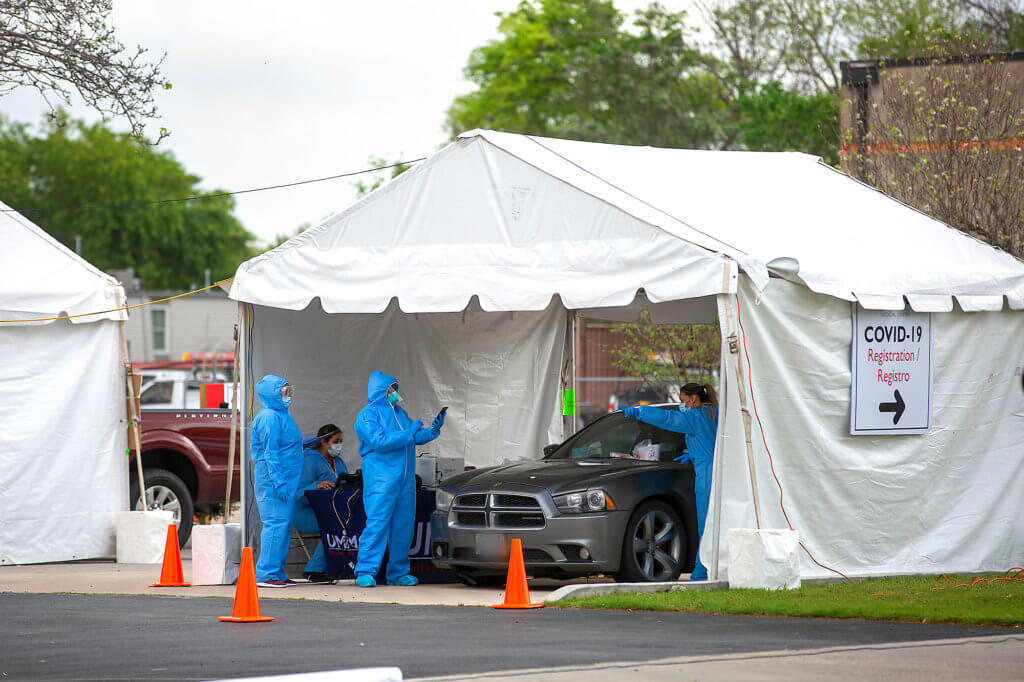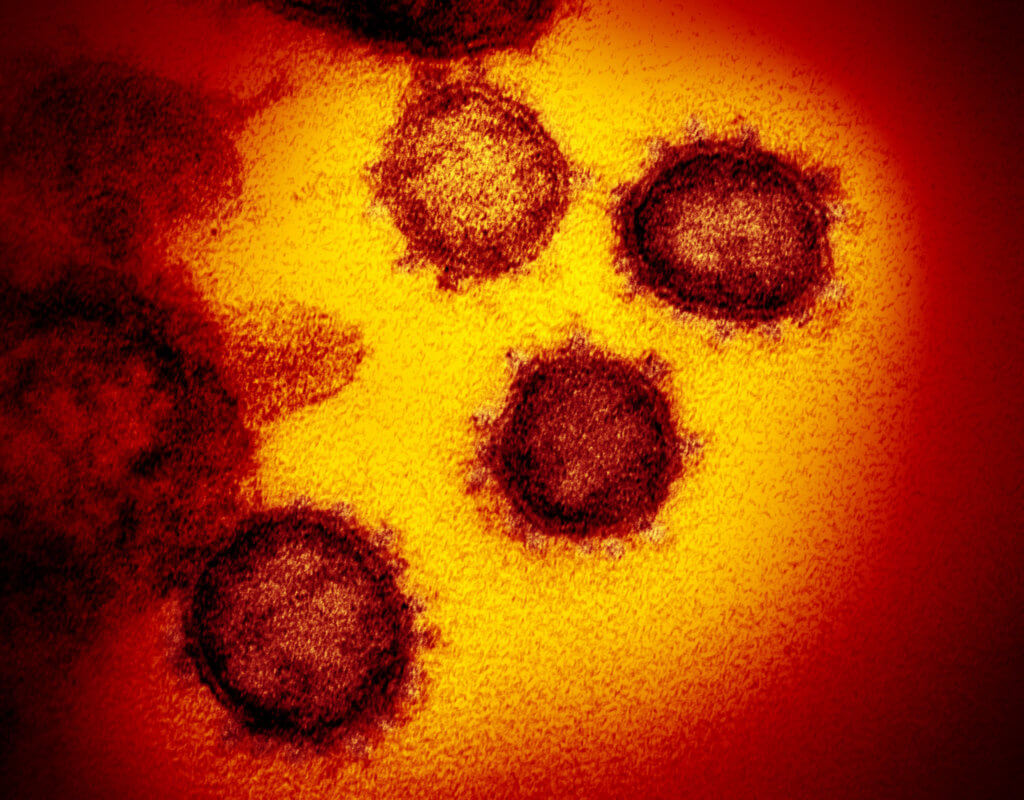Can the coronavirus spread through the air?

In the early days of the COVID-19 pandemic, many experts assumed that the novel coronavirus was transmitted by direct or close contact with infected people who released small respiratory droplets when they coughed, sneezed, talked or sang. Touching contaminated surfaces, called fomite transmission, was also believed to be a key way for the virus to spread.
However, a growing body of research shows that airborne transmission of the virus through aerosols—microscopic respiratory droplets 5 μm or smaller in size—is possible and should not be ruled out.
Once the aerosols are airborne, the water in the tiny droplets quickly evaporates, leaving even smaller virus particles that can float in the air for an extended period of time. One study showed that SARS-CoV-2, the virus that causes COVID-19 disease, can remain viable in aerosolized form for three hours, while another found that the virus could live up to 16 hours in the air in certain indoor conditions.
::::::::::::::::::::::::::::::::::::::::::::::::::::::::::::::::::::::::::::::::::::::::::::::::::::::::::::::::::::::::::::::::::::::::::::::::::::::
Looking for the latest on the CORONAVIRUS? Read our daily updates HERE.
::::::::::::::::::::::::::::::::::::::::::::::::::::::::::::::::::::::::::::::::::::::::::::::::::::::::::::::::::::::::::::::::::::::::::::::::::::::
This emerging research prompted 239 scientists to write an open letter to public health organizations, chiefly the World Health Organization (WHO), urging them to consider aerosolized virus particles as a possible route of transmission.
“Most public health organizations, including the World Health Organization, do not recognize airborne transmission except for aerosol-generating procedures performed in health care settings,” the scientists wrote, referring to procedures including the drilling of teeth, which can release microscopic respiratory droplets. “Hand washing and social distancing are appropriate, but in our view, insufficient to provide protection from virus-carrying respiratory microdroplets released into the air by infected people.”
The scientists do not want to rule out any mode of transmission for SARS-CoV-2.
“We need to understand that many respiratory viruses are transmitted by more than one route—by both small and large aerosol particles,” said Pedro Piedra, M.D., professor of virology and microbiology at Baylor College of Medicine. “We’re in a pandemic and, although we don’t know for certain the role and the significance of small aerosol transmission, there’s a consensus that it’s playing an important role.”
Shortly after the group of scientists publicly appealed to the WHO, the international health organization adjusted its stance on airborne transmission in a scientific brief, stating that “a susceptible person could inhale aerosols, and could become infected if the aerosols contain the virus in sufficient quantity to cause infection within the recipient.”
“We acknowledge that there is emerging evidence in this field … regarding the COVID-19 virus and pandemic, and therefore, we believe that we have to be open to this evidence and understand its implications regarding the modes of transmission and also regarding the precautions that need to be taken,” said Benedetta Allegranzi, M.D., the WHO’s technical lead of infection prevention and control, during a news conference.
Learning more about SARS-CoV-2
Because so little was known about the novel coronavirus when it emerged in December 2019 in China, scientists had to make assumptions about how spread was occurring based on previous viruses.
“When this outbreak first began, of course, we knew nothing about this SARS-CoV-2,” said Scott Weaver, Ph.D., scientific director of the Galveston National Laboratory and director of the Institute for Human Infections and Immunity at The University of Texas Medical Branch at Galveston. “We did know a little bit about the first SARS coronavirus and other coronaviruses, and we knew a lot more about other kinds of respiratory viruses, like influenza. Initially, the assumptions were that a lot of the spread was either through direct contact between people … or contamination of surfaces.”
But as scientists learned more about the novel coronavirus, they discovered that SARS-CoV-1 and SARS-CoV-2 were quite different in a few key ways.
First, people who were spreading the first SARS coronavirus in 2002 were symptomatic at the time, making it easier to screen and identify infected individuals at airports, for example. Conversely, new research shows that SARS-CoV-2 is often spread by pre-symptomatic and asymptomatic people. According to Centers for Disease Control and Prevention (CDC) estimates, approximately 50 percent of infections come from pre-symptomatic transmission and 40 percent of infections are from asymptomatic transmission.
Second, SARS-CoV-2 appears to be more stable in aerosol particles than the first SARS coronavirus, which Weaver said may, in part, explain why the novel coronavirus spread around the world, whereas SARS-CoV only reached a few countries.
“A lot of these assumptions have changed over time as we learn more about this new coronavirus,” Weaver continued. “I think the best evidence that it’s not just fomites and small drops but actual aerosols that are responsible for at least some of the spread is that there have been instances where large numbers of people have become infected from a single person shedding in an indoor environment, where it’s unlikely that they all got close enough to that person for large droplet or fomite transmission.”
A choir rehearsal north of Seattle was the first major example of aerosol transmission. In March 2020, 61 people attended a chorale practice in Mount Vernon, Washington in which one symptomatic superspreader infected 87 percent of the group, leading scientists to believe that the vigorous vocals produced and propelled aerosolized virus particles.
Airborne transmission is another reason why experts believe bars and other loud gatherings held indoors are high risk.
“There have recently been cases where people have attended large parties or gone to bars, and a lot of people became infected,” Weaver said. “Those are conditions of enclosed spaces, people not maintaining social distancing, not wearing masks, mingling, moving about the room over time, that are ideal for airborne spread. … When people are singing or talking very loudly, they produce a much larger volume of aerosols and expel it further away from themselves.”
Acknowledging the presence of aerosol transmission will help promote the development of environmental instruments and engineering to improve ventilation and disinfect small particles for a more sterilized environment, especially in high-risk places.
Size doesn’t matter
While the scientific community and the WHO may disagree on the role aerosol transmission plays in the pandemic, some experts say that the size of the particles is not the major issue.
“Regardless of what route of transmission is occurring, whether it’s small particle or large particle aerosols, we know we can have a major impact simply by reducing the contact that occurs with good social distancing and with masks,” Piedra explained. “Many respiratory viruses are transmitted by a number of routes, including small and large particles. We know that there are things that we have done that worked to really curtail the spread within our community.”
As new information about SARS-CoV-2 comes to light, Weaver said he hopes people will assume more personal responsibility for transmission of the virus.
“We all have family members and friends who could very well die from COVID,” Weaver added. “We all have to do our part to prevent that and get us through this crisis.”




